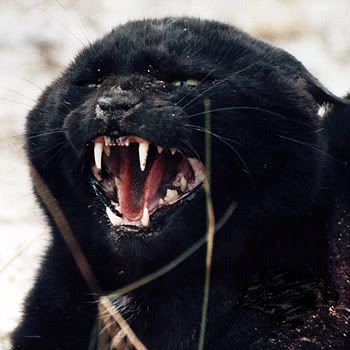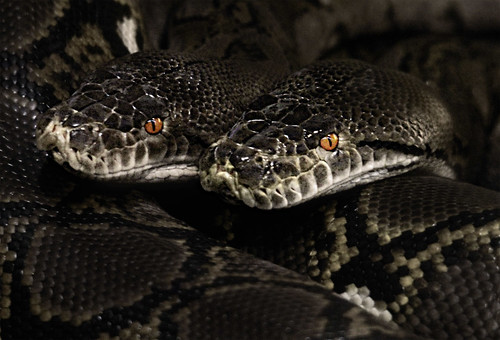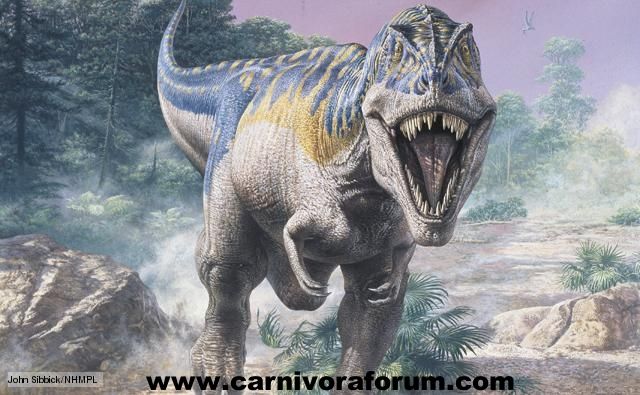Post by DinosaurMichael on Mar 2, 2012 7:38:53 GMT -5
Jaguar - Panthera onca
The jaguar ( /ˈdʒæɡwɑr/ or UK /ˈdʒæɡjuː.ər/; Panthera onca) is a big cat, a feline in the Panthera genus, and is the only Panthera species found in the Americas. The jaguar is the third-largest feline after the tiger and the lion, and the largest in the Western Hemisphere. The jaguar's present range extends from Southern United States and Mexico across much of Central America and south to Paraguay and northern Argentina. Apart from a known and possibly breeding population in Arizona (southeast of Tucson), the cat has largely been extirpated from the United States since the early 20th century. This spotted cat most closely resembles the leopard physically, although it is usually larger and of sturdier build and its behavioural and habitat characteristics are closer to those of the tiger. While dense rainforest is its preferred habitat, the jaguar will range across a variety of forested and open terrain. It is strongly associated with the presence of water and is notable, along with the tiger, as a feline that enjoys swimming. The jaguar is largely a solitary, opportunistic, stalk-and-ambush predator at the top of the food chain (an apex predator). It is a keystone species, playing an important role in stabilizing ecosystems and regulating the populations of the animals it hunts. The jaguar has an exceptionally powerful bite, even relative to the other big cats. This allows it to pierce the shells of armoured reptiles and to employ an unusual killing method: it bites directly through the skull of prey between the ears to deliver a fatal bite to the brain. The jaguar is a compact and well-muscled animal. There are significant variations in size and weight: weights are normally in the range of 56–96 kilograms (124–211 lb). Larger males have been recorded at as much as 160 kg (350 lb) (roughly matching a tigress or lioness), and the smallest females have low weights of 36 kg (79 lb). Females are typically 10–20% smaller than males. The length of the cat varies from 1.2 to 1.95 m (3.9 to 6.4 ft), and its tail may add a further 45 to 75 cm (18 to 30 in). It stands about 63 to 76 cm (25 to 30 in) tall at the shoulders. Like the slightly smaller Old World leopard, this cat is relatively short and stocky in build. Further variations in size have been observed across regions and habitats, with size tending to increase from the north to south. A study of the jaguar in the Chamela-Cuixmala Biosphere Reserve on the Mexican Pacific coast, showed ranges of just about 50 kilograms (110 lb), about the size of the cougar. By contrast, a study of the Jaguar in the Brazilian Pantanal region found average weights of 100 kilograms (220 lb) and weights of 136 kilograms (300 lb) or more are not uncommon in old males. Forest jaguars are frequently darker and considerably smaller than those found in open areas (the Pantanal is an open wetland basin), possibly due to the smaller numbers of large herbivorous prey in forest areas. A short and stocky limb structure makes the jaguar adept at climbing, crawling and swimming. The head is robust and the jaw extremely powerful. The jaguar has the strongest bite of all felids, capable of biting down with 2,000 pounds-force (8,900 N). This is twice the strength of a lion and the second strongest of all mammals after the spotted hyena; this strength is an adaptation that allows the jaguar to pierce turtle shells. A comparative study of bite force adjusted for body size ranked it as the top felid, alongside the clouded leopard and ahead of the lion and tiger. It has been reported that "an individual jaguar can drag a 360 kg (800 lb) bull 8 m (25 ft) in its jaws and pulverize the heaviest bones". The jaguar hunts wild animals weighing up to 300 kilograms (660 lb) in dense jungle, and its short and sturdy physique is thus an adaptation to its prey and environment. The base coat of the jaguar is generally a tawny yellow, but can range to reddish-brown and black. The cat is covered in rosettes for camouflage in its jungle habitat. The spots vary over individual coats and between individual Jaguars: rosettes may include one or several dots, and the shape of the dots varies. The spots on the head and neck are generally solid, as are those on the tail, where they may merge to form a band. The underbelly, throat and outer surface of the legs and lower flanks are white. While the jaguar closely resembles the leopard, it is sturdier and heavier, and the two animals can be distinguished by their rosettes: the rosettes on a jaguar's coat are larger, fewer in number, usually darker, and have thicker lines and small spots in the middle that the leopard lacks. Jaguars also have rounder heads and shorter, stockier limbs compared to leopards.

American Black Bear - Ursus americanus
The American black bear or North American black bear (Ursus americanus) is a medium-sized bear native to North America. It is the continent's smallest and most common bear species. Black bears are omnivores, with their diets varying greatly depending on season and location. They typically live in largely forested areas, but do leave forests in search of food. Sometimes they become attracted to human communities because of the immediate availability of food. The American black bear is listed by the IUCN as Least Concern, due to the species' widespread distribution and a large global population estimated to be twice that of all other bear species combined. American black bears often mark trees using their teeth and claws as a form of communication with other bears, a behavior common to many species of bears. Black bear weight tends to vary according to age, sex, health, and season. Seasonal variation in weight is very pronounced: in autumn, their pre-den weight tends to be 30% higher than in spring, when black bears emerge from their dens. Black bears on the East Coast tend to be heavier on average than those on the West Coast. Adult males typically weigh between 57–250 kg (130–550 lb), while females weigh 33% less at 41–170 kg (90–370 lb). Adults have a typical size range of 120–200 cm (47–79 in) in length, and 70–105 cm (28–41 in) in shoulder height. The tail is 7.7–17.7 cm (3.0–7.0 in) long. Although they are the smallest species in North America, large males exceed the size of other bear species except the Brown and Polar Bears. The biggest wild American black bear ever recorded was a male from New Brunswick, shot in November 1972, that weighed 409 kg (900 lb) after it had been dressed, meaning it weighed an estimated 500 kg (1,100 lb) in life, and measured 2.4 m (7.9 ft) long. The North American Bear Center, located in Ely, Minnesota, is home to the world's largest captive male and female black bears. Ted, the male, weighed 950–1,000 lb (430–450 kg) in the fall of 2006. Honey, the female, weighed 555.5 lb (252.0 kg) in the fall of 2007. Adult black bears are mostly nocturnal, but juveniles are often active in daytime.

The jaguar ( /ˈdʒæɡwɑr/ or UK /ˈdʒæɡjuː.ər/; Panthera onca) is a big cat, a feline in the Panthera genus, and is the only Panthera species found in the Americas. The jaguar is the third-largest feline after the tiger and the lion, and the largest in the Western Hemisphere. The jaguar's present range extends from Southern United States and Mexico across much of Central America and south to Paraguay and northern Argentina. Apart from a known and possibly breeding population in Arizona (southeast of Tucson), the cat has largely been extirpated from the United States since the early 20th century. This spotted cat most closely resembles the leopard physically, although it is usually larger and of sturdier build and its behavioural and habitat characteristics are closer to those of the tiger. While dense rainforest is its preferred habitat, the jaguar will range across a variety of forested and open terrain. It is strongly associated with the presence of water and is notable, along with the tiger, as a feline that enjoys swimming. The jaguar is largely a solitary, opportunistic, stalk-and-ambush predator at the top of the food chain (an apex predator). It is a keystone species, playing an important role in stabilizing ecosystems and regulating the populations of the animals it hunts. The jaguar has an exceptionally powerful bite, even relative to the other big cats. This allows it to pierce the shells of armoured reptiles and to employ an unusual killing method: it bites directly through the skull of prey between the ears to deliver a fatal bite to the brain. The jaguar is a compact and well-muscled animal. There are significant variations in size and weight: weights are normally in the range of 56–96 kilograms (124–211 lb). Larger males have been recorded at as much as 160 kg (350 lb) (roughly matching a tigress or lioness), and the smallest females have low weights of 36 kg (79 lb). Females are typically 10–20% smaller than males. The length of the cat varies from 1.2 to 1.95 m (3.9 to 6.4 ft), and its tail may add a further 45 to 75 cm (18 to 30 in). It stands about 63 to 76 cm (25 to 30 in) tall at the shoulders. Like the slightly smaller Old World leopard, this cat is relatively short and stocky in build. Further variations in size have been observed across regions and habitats, with size tending to increase from the north to south. A study of the jaguar in the Chamela-Cuixmala Biosphere Reserve on the Mexican Pacific coast, showed ranges of just about 50 kilograms (110 lb), about the size of the cougar. By contrast, a study of the Jaguar in the Brazilian Pantanal region found average weights of 100 kilograms (220 lb) and weights of 136 kilograms (300 lb) or more are not uncommon in old males. Forest jaguars are frequently darker and considerably smaller than those found in open areas (the Pantanal is an open wetland basin), possibly due to the smaller numbers of large herbivorous prey in forest areas. A short and stocky limb structure makes the jaguar adept at climbing, crawling and swimming. The head is robust and the jaw extremely powerful. The jaguar has the strongest bite of all felids, capable of biting down with 2,000 pounds-force (8,900 N). This is twice the strength of a lion and the second strongest of all mammals after the spotted hyena; this strength is an adaptation that allows the jaguar to pierce turtle shells. A comparative study of bite force adjusted for body size ranked it as the top felid, alongside the clouded leopard and ahead of the lion and tiger. It has been reported that "an individual jaguar can drag a 360 kg (800 lb) bull 8 m (25 ft) in its jaws and pulverize the heaviest bones". The jaguar hunts wild animals weighing up to 300 kilograms (660 lb) in dense jungle, and its short and sturdy physique is thus an adaptation to its prey and environment. The base coat of the jaguar is generally a tawny yellow, but can range to reddish-brown and black. The cat is covered in rosettes for camouflage in its jungle habitat. The spots vary over individual coats and between individual Jaguars: rosettes may include one or several dots, and the shape of the dots varies. The spots on the head and neck are generally solid, as are those on the tail, where they may merge to form a band. The underbelly, throat and outer surface of the legs and lower flanks are white. While the jaguar closely resembles the leopard, it is sturdier and heavier, and the two animals can be distinguished by their rosettes: the rosettes on a jaguar's coat are larger, fewer in number, usually darker, and have thicker lines and small spots in the middle that the leopard lacks. Jaguars also have rounder heads and shorter, stockier limbs compared to leopards.

American Black Bear - Ursus americanus
The American black bear or North American black bear (Ursus americanus) is a medium-sized bear native to North America. It is the continent's smallest and most common bear species. Black bears are omnivores, with their diets varying greatly depending on season and location. They typically live in largely forested areas, but do leave forests in search of food. Sometimes they become attracted to human communities because of the immediate availability of food. The American black bear is listed by the IUCN as Least Concern, due to the species' widespread distribution and a large global population estimated to be twice that of all other bear species combined. American black bears often mark trees using their teeth and claws as a form of communication with other bears, a behavior common to many species of bears. Black bear weight tends to vary according to age, sex, health, and season. Seasonal variation in weight is very pronounced: in autumn, their pre-den weight tends to be 30% higher than in spring, when black bears emerge from their dens. Black bears on the East Coast tend to be heavier on average than those on the West Coast. Adult males typically weigh between 57–250 kg (130–550 lb), while females weigh 33% less at 41–170 kg (90–370 lb). Adults have a typical size range of 120–200 cm (47–79 in) in length, and 70–105 cm (28–41 in) in shoulder height. The tail is 7.7–17.7 cm (3.0–7.0 in) long. Although they are the smallest species in North America, large males exceed the size of other bear species except the Brown and Polar Bears. The biggest wild American black bear ever recorded was a male from New Brunswick, shot in November 1972, that weighed 409 kg (900 lb) after it had been dressed, meaning it weighed an estimated 500 kg (1,100 lb) in life, and measured 2.4 m (7.9 ft) long. The North American Bear Center, located in Ely, Minnesota, is home to the world's largest captive male and female black bears. Ted, the male, weighed 950–1,000 lb (430–450 kg) in the fall of 2006. Honey, the female, weighed 555.5 lb (252.0 kg) in the fall of 2007. Adult black bears are mostly nocturnal, but juveniles are often active in daytime.










